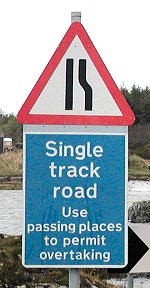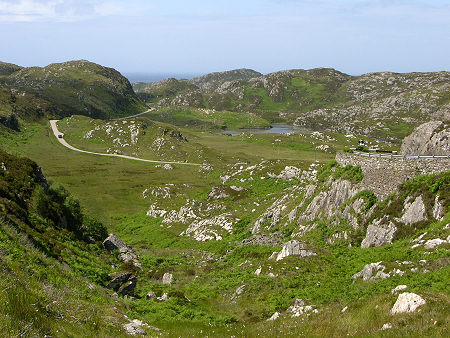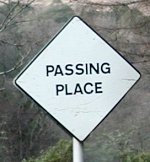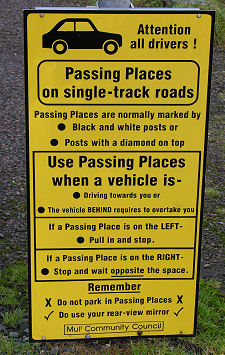 The Single Track B8043 North of Kingairloch in Morvern |
You have to look much harder to find single track roads in Scotland than used to be the case: but they're still there. As you travel further north and west, and in particular on Scotland's islands, you will sooner or later find yourself on a road too narrow to pass the vehicle coming the other way towards you.
Driving these roads requires thought and concentration. There are usually plenty of passing places (but they can get fewer and further between on more minor roads), and these are usually, but not always, marked with one of the signs shown on this page or with the striped pole also shown. But unless you want to make yourself very unpopular, remember that these are passing and not parking places.
The trick on single track roads is to drive with a combination of consideration and assertiveness. In an ideal world, vehicles approaching one another should adjust their speeds so as to meet at a passing place. That way neither waits for the other and both proceed at best speed. It is also worth remembering that we do drive on the left in the UK; and even on a single track road it pays to keep to the left as much as possible. That way, if you do meet someone you've not seen coming the other way, who hasn't seen you, you both stand the best chance of avoiding actual physical contact.
Bear in mind that if the passing place is on the right and you reach it first, you should stop on the left side of the road opposite the passing place: pulling across to the right is as good a way to lose your no-claims bonus as any. And whichever side the passing place is on, the rule is that the person who reaches it first should stop. Driving through a passing place when you can see you are going to meet an oncoming vehicle before the next one is bad driving. Also bear in mind the - not always well respected - convention that traffic going downhill should try to be considerate to traffic going uphill.
You can't always see far enough ahead on these roads to plan well in advance, and the judgement can be a fine one. So think ahead, look as far ahead as possible, be prepared to give way and wait, and be equally prepared to be positive. But when approaching that blind bend or summit, keep in mind one important thought: if you met yourself coming the other way, could you both stop? And always remember the next corner could conceal an oncoming refuse truck or articulated lorry full of fish or logs. Or a driver used to driving on the right hand side of the road who's reverted to doing so in the absence of white lines.
You should also be on the lookout for road users whose needs are different from your own, whether they are cyclists, pedestrians or horse riders: or sheep, cattle or even goats. Common sense and consideration pay dividends in these circumstances, and such road users should always be given as much room as possible. Many single track roads are not wide enough between passing places to allow a car safely to pass a cyclist heading in either direction, and attempting to do so can all to easily result in your forcing someone off the road into a peat bog or a gorse bush. And there are times when the only way to pass a herd of cattle or sheep is to stop, turn off your engine, and wait for the herd to be driven past you.
There's a point of view that suggests that we tourists ought to be more prepared to give way to people making their living by driving these roads, and we've got a lot of sympathy for that. You should also bear in mind that the driver of the white van coming towards you probably doesn't own his vehicle, and therefore probably cares less about it than you do about your car. This, too, argues in favour of a conservative approach. But not a timid one: if you are timid on these roads you could be in for some very, very slow journeys.
 |
 |
If you do find yourself nose to nose with someone between passing places (and it does happen, even between attentive and considerate drivers), then the person who can most easily reverse to a passing place should do so. This usually means the person closest to a passing place should do the reversing: but gradient, type of vehicle, and number of vehicles that would have to reverse can be factors too. The obvious implication of this is that you should never drive a vehicle - with or without a trailer - on a single track road that you cannot readily reverse should the need arise.
Finally, don't let your concentration on what's coming the other way stop you keeping a close watch on your mirror. If someone comes up behind you, they're obviously travelling the road faster than you and you are obliged to use a passing place to pull over and let them through. This is more than simple courtesy: the road signs on this page emphasise the point. And anyway, it is much more comfortable travelling these roads without a queue of traffic behind you.
Driving single track roads can be hard work, but they are part of the character of the Highlands and Islands. Think ahead and pay attention, and try not to be distracted by the stunning scenery in which so many of them are found.
 The Single Track B869 North of Lochinver |






